Ga. forests could fuel carbon-neutral aviation
New season of tracking YLH begins
Tips to stabilize farm accident victims

'22 AG CENSUS THE NUMBERS ARE IN
News Vol. 86 No.2 Summer 2024 GEORGIA FARM BUREAU


2 Summer 2024 Georgia Farm Bureau News $500 Exclusive Cash Reward* Ford Super Duty *Farm Bureau Exclusive Cash Reward is exclusively for active Farm Bureau members who are residents of the United States. $500 Exclusive Cash Reward on the purchase or lease of an eligible new 2023/2024/2025 Ford Maverick, Ranger, F-150, Super Duty or F-150 Lightning. This incentive is not available on Ranger Raptor®, F-150 Raptor, F-650® and F-750® Super Duty. This offer may not be used in conjunction with most other Ford Motor Company private incentives or AXZD-Plans. Some customer and purchase eligibility restrictions apply. Must be a Farm Bureau member for 30 consecutive days prior to purchase or lease and take new retail delivery from an authorized Ford Dealer’s stock by January 2, 2025. See your authorized Ford Dealer for qualifications and complete details. Note to dealer: Claim in VINCENT using #32286. Farm Bureau Members receive $500* toward an eligible new F-150® Lightning®, Super Duty®, F-150, Ranger® or Maverick® . Visit FordRecognizesU.com/FarmBureau today for complete offer details!

pages 6 - 8
2022 Census of Agriculture:
The Numbers Are In Government agencies and lawmakers use ag census data to make policy and budgeting decisions. Learn what the latest census says about Georgia agriculture.
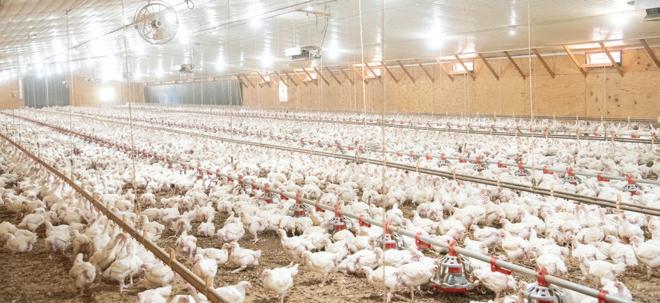
pages 9 - 11
Georgia forests could fuel carbon-neutral aviation
The federal government’s Sustainable Aviation Fuel (SAF) Grand Challenge aims to produce 3 billion gallons of SAF by 2030 and 35 billion gallons by 2050.

Departments
page 4
View from the Field
page 5
Public Policy
pages 24 & 25
Ga. Foundation for Agriculture
page 27
Ag in the Classroom
page 28
Young Farmers & Ranchers
page 29
Women's Leadership
Want to subscribe? Join Georgia Farm Bureau to receive GFB News four times a year. Your membership supports farmers & agriculture while giving you access to more than 300,000 discounts. Visit gfb.ag/join.
pages 12 & 13
Farm bill, NASS key topics on GFB trip to D.C. GFB members and staff visited Washington, D.C., this spring to meet with Georgia’s congressional delegation to discuss issues affecting their farms.
pages 14 & 15
Avian flu found in dairy cattle
For the first time since avian flu was found in birds about 20 years ago, the virus has been detected in dairy cattle.

pages 16 & 17
New season of tracking & eradicating YLH begins It’s time to resume watching for the invasive yellow-legged hornet first spotted in Savannah last August.
GFB News Staff
Kenny Burgamy Director
Jennifer Whittaker Editor
Jay Stone News Reporter
Jared McGukin Graphic Designer
Logan Thomas Photographer
pages 18 & 19
Georgia Department of Ag celebrates 150 years
pages 20 & 21
Injured in a farm accident? Tips to help Statesboro trauma surgeon Dr. John Martin shares tips for stabilizing a victim until emergency medical professionals arrrive.
page 22
GA Jr. Livestock Champions win cash & buckles
page 26
GFA awards scholarships to help students pursue ag careers
page 31
GFB & Wesleyan College agreement offers scholarships
FOLLOW US ON THESE PLATFORMS @GAFARMBUREAU
On The Cover:
Photo by Logan Thomas
For information concerning advertising, contact Wendy McFarland at 334-6529080 or mcfarlandadvantage@gmail.com. For questions about your membership or member benefits, call 1-800-633-5432. For questions regarding editorial content call 478-474-0679, ext. 5334 or e-mail jawhittaker@gfb.org.
Summer 2024 3 Georgia Farm Bureau News
Contents
View from the Field
Tom McCall, GFB President News
It was such a pleasure in April and May to see Gov. Kemp sign several bills, which Georgia Farm Bureau supported, that will benefit our state’s farmers.
Your GFB Public Policy team helped lawmakers over the past two sessions with legislation that prevents ownership of agricultural land or land near military installations by certain individuals acting as an agent of a foreign adversary.
In working on Senate Bill 420, sponsored by Sen. Jason Anavitarte, we felt it important that the legislation prohibit the ownership or acquisition of agricultural land or nonresidential land within a 10-mile radius of a military location by a nonresident acting as an agent of a government designated as a foreign adversary, entity owned in certain countries, or governments of countries designated as a foreign adversary by the U.S. Secretary of Commerce.
This law will ban agents of China, Cuba, Iran, North Korea, Russia and Venezuela who are not U.S. citizens or legal residents from owning any land in Georgia, except for residential property, within 10 miles of a military installation unless they have spent at least 10 months of the previous year living in Georgia.
Other states have already signed similar bills with strict bans, too.
I have long said this is a national security issue. Simply put, we can’t have foreign adversaries controlling something as critical as our food supply.
We also appreciate the work state legislators did to address other ag issues, such as passing legislation to restore private property rights to landowners adjacent to navigable waters. You can read about House Bill 1172 by Rep. James Burchett on page 5.
It is important issues like these that your GFB policy team engages in during the legislative session every year. They do a premier job of representing Georgia farmers in the legislative arena, GFB’s primary purpose.
It is clear to see how effective their efforts are when we see Gov. Kemp sign important bills that protect all Georgia farmers and the future of our safe and abundant food supply.
Thank you for allowing Jane and me to serve you.
 Tom McCall, GFB President
Tom McCall, GFB President

OFFICERS
President
TOM McCALL, Elbert Co.
1st Vice President &
South Georgia Vice President
DANIEL JOHNSON, Pierce Co.
North Georgia Vice President
BERNARD SIMS, Catoosa Co.
Middle Georgia Vice President
RALPH CALDWELL, Heard County
General Counsel
DUKE GROOVER
Chief Financial Officer, Corp. Treasurer & GFBMIC Exec. VP
DAVID JOLLEY
Chief Administrative Officer
JEFFREY HARVEY
Corporate Secretary & Senior Counsel
JEANNA FENNELL
Asst. Corp. Treasurer & Sr. Director of Accounting
RACHEL MOSELY
DIRECTORS
FIRST DISTRICT: Bill Bryan, Chattooga Co.; Wesley Hall, Forsyth Co. SECOND DISTRICT: Gilbert Barrett, Habersham Co.; Russ Moon, Madison Co.THIRD DISTRICT: Brad Marks, Newton Co. FOURTH DISTRICT: Skeetter McCorkle, McDuffie Co.; Russ Wilburn, Barrow Co. FIFTH DISTRICT: Matt Bottoms, Pike Co.; Leighton Cooley, Crawford Co. SIXTH DISTRICT: James Malone, Laurens Co.; James Emory Tate, Jeff Davis Co. SEVENTH DISTRICT: Gary Bell, Evans Co.; Ben Boyd, Screven Co. EIGHTH DISTRICT: Scotty Raines, Turner Co.; Don Wood, Wilcox Co. NINTH DISTRICT: Lucius Adkins, Baker Co.; Paul Shirah, Mitchell Co. TENTH DISTRICT: David Lee, Bacon Co.; Lamar Vickers, Berrien Co. YOUNG FARMERS & RANCHERS CHAIR: Cleve Jackson, Floyd Co. WOMEN’S LEADERSHIP CHAIR: Stephanie Branch, Rabun Co.
ADVERTISING POLICY
All advertising accepted subject to publisher’s approval. Advertisers must assume liability for content of their advertising. Publisher maintains right to cancel advertising for non-payment or reader complaint about advertiser service or products. Publisher does not accept per-order, political or alcoholic beverage ads, nor does publisher prescreen or guarantee advertiser service or products. Publisher assumes no liability for products or services advertised in the Georgia Farm Bureau News. For advertising rates and information, contact Wendy McFarland at 334-652-9080 or mcfarlandadvantage@gmail.com. Georgia Farm Bureau News was established in 1937. Copyright 2024 by the Georgia Farm Bureau Federation. Printed by Panaprint, Macon, Georgia.
4 Summer 2024 Georgia Farm Bureau News
GEORGIA FARM BUREAU
GFB President Tom McCall, his wife, Jane and grandchildren, McCall Archer, Wilkes & Winn McCall.
Public Policy Update
General Assembly passes multiple pro-ag bills
By Adam Belflower
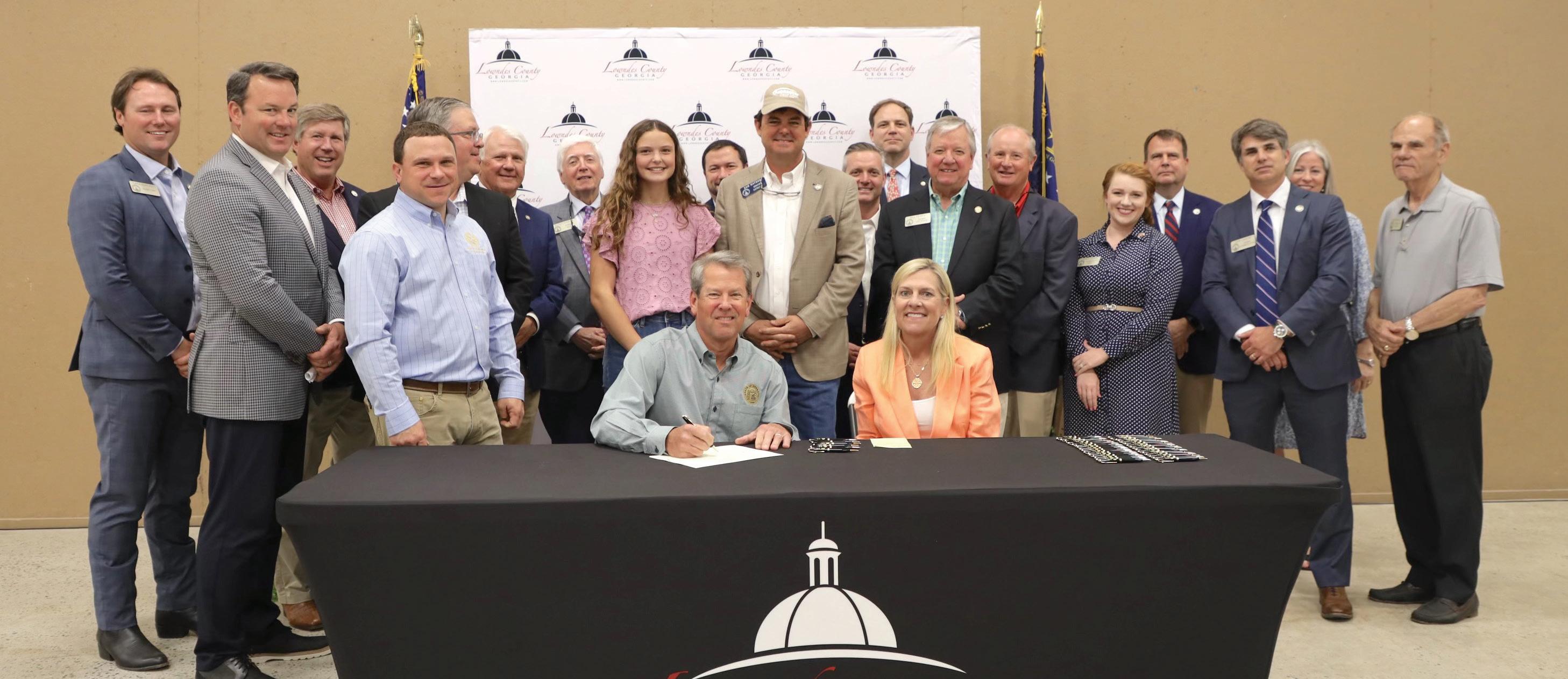
On March 28, the Georgia General Assembly marked the end of the 2024-2025 legislative biennium. This was a successful year for Georgia agriculture with the General Assembly passing multiple pieces of legislation promoting the continued success of our farmers.
We were happy to see Georgia Farm Bureau’s priority issue House Bill (HB) 1172, by Rep. James Burchett, pass both the House and Senate. HB 1172 removes reference to the public trust doctrine as it applies to navigable waters and restores private property rights to landowners adjacent to navigable waters.
This bill is important because it addresses unintended consequences from SB 115, legislation state legislators passed last year, while still allowing the public to pass, hunt, and fish on navigable waters, the bill’s original intent.
Rep. Burchett’s work on this issue began last fall as he chaired the House Study Committee on Fishing Access to Freshwater Resources. HB 1172 came as a recommendation from the study committee. We are grateful for Rep. Burchett’s leadership on this issue.
GFB also wants to recognize Sen. Sam Watson, who was also instrumental in passing this bill. He authored a similar bill in the Senate and was the bill sponsor of HB 1172 once it crossed over. Look for updates from your GFB Staff as we wait to see what action Gov. Brian Kemp will take on HB 1172.
While HB 1172 addressed the rights of landowners and the ability of the public to access navigable waters, HR 1554 by Rep. Lynn Smith, continues the discussion of private property rights by creating the House Study Committee on Navigable Streams
and Related Matters. The goal of this committee is to delineate and clarify which waters in Georgia are navigable and nonnavigable. The work of this committee has significant impact for private property rights because it will recommend to the General Assembly which waterways in Georgia are open for public access.
Two other important bills GFB helped pass this year were SB 420 and 340. SB 420 by Sen. Jason Anavitarte prohibits the foreign acquisition of farmland by foreign adversaries –protecting our domestic food supply and allowing Georgia farmers to feed our country.
Working with Rep. Joe Campbell, we were able to get SB 340 passed, which makes diesel exhaust fluid an eligible purchase under the Georgia Agricultural Tax Exemption (GATE) program.
On April 30 Gov. Kemp signed five ag-related bills at a ceremony in Valdosta. HB 827 by Rep. Tyler Paul Smith increases the penalties of livestock theft from two to 15 years of imprisonment with a fine of $10,000. SB 494 by Sen. Sam Watson, known as the “Georgia Hemp Farming Act,” creates regulations the Georgia Department of Agriculture needed to police Georgia’s hemp industry. SB 436, also by Watson, changes the definition of “Farm Use Vehicle” as it relates to road right-of-way to include any lawful operators of tractors or husbandry implement used primarily for agriculture. SB 340 and 420 were also signed during this ceremony.
Adam Belflower is a GFB Governmental Affairs Specialist. He may be reached at acbelflower@gfb.org or 478-474-8411, ext. 5259.
Summer 2024 5 Georgia Farm Bureau News
Gov. Brian Kemp signed five bills beneficial to Georgia farmers on April 30. /Photo courtesy of Gov. Kemp's office
 By Jennifer Whittaker
By Jennifer Whittaker
'22 AGRICULTURE CENSUS
What do baseball and agriculture have in common? Both have a lot of statistics!
The USDA National Agricultural Statistics Service (NASS) conducts the Census of Agriculture (COA) every five years. USDA released the 2022 COA report Feb. 13. NASS reports the national response rate for the 2022 COA was 61%. Georgia’s response rate was 54.6%, said Anthony Prillaman, director of the USDA NASS Southern Region, which covers Georgia, Alabama, Florida and South Carolina.
"I want to thank all the farmers and ranchers who responded to the 2022 Census of Agriculture," said Prillaman. “The data will inform decisions about policy, farm and conservation programs, rural development, research, technology development, ag education, and more over the next several years.”
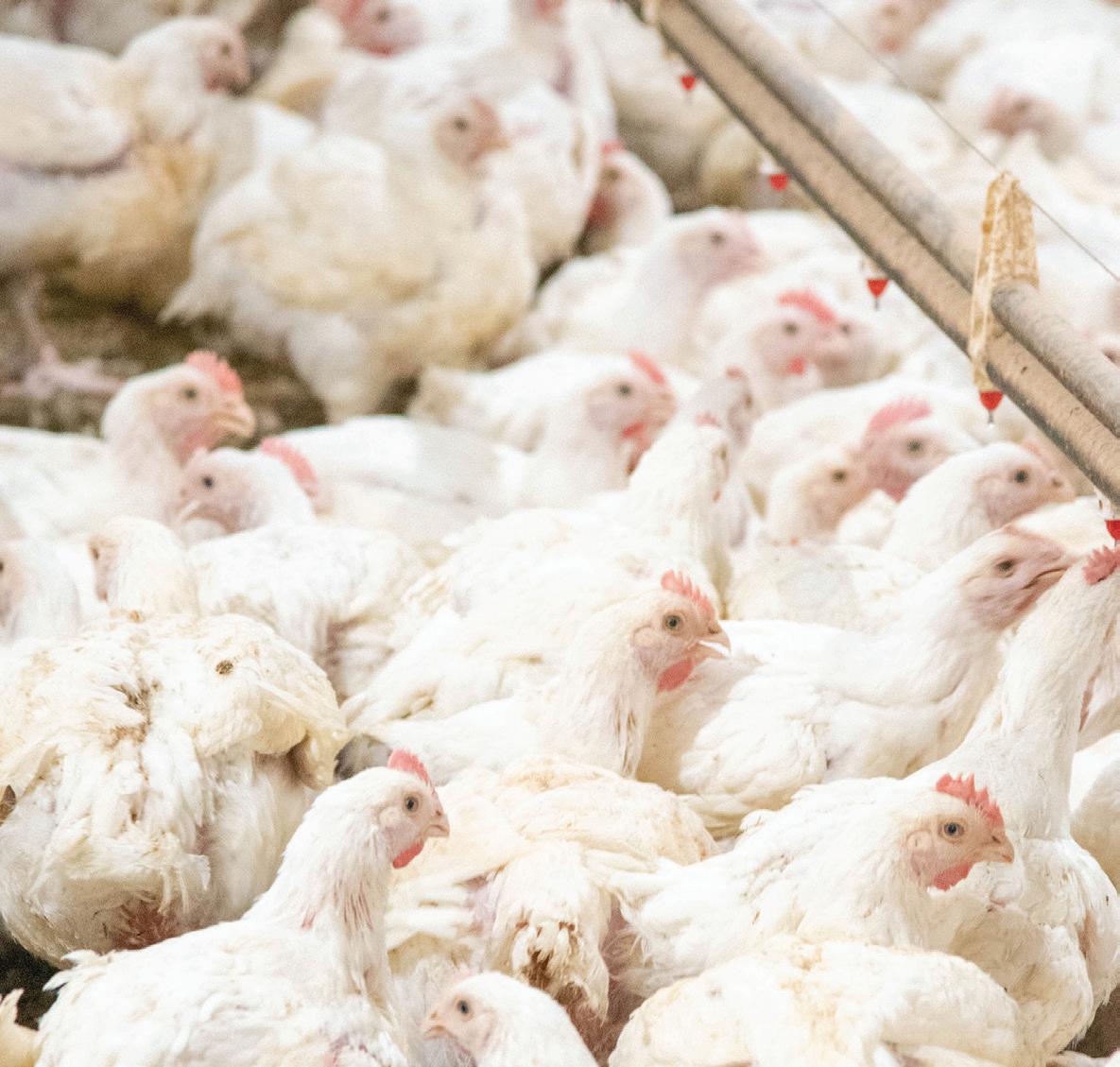

A census summary for every Georgia county is available at https://gfb.ag/22GAcensus .
VITAL STATS
The USDA defines a farm as any place that produces and sells $1,000 or more of agricultural products or would have in the census year.
Between 2017 and 2022, the number of U.S. producers held steady at 3.4 million.
Georgia has 67,082 producers the 2022 census shows, while it had 68,087 producers in 2017. That’s a loss of 1,005 producers.
The latest census shows there are 1.9 million farms/ranches in the U.S. That’s down 7% from the 2017 census when there were 2.04 million. The total amount of farmland in the U.S. is 880.1 million acres, down 2% from 900 million in 2017.
Census data shows Georgia has 39,264 farms. In 2017, Georgia reported 42,439 farms. That’s a 7% loss or 3,175 farms. Georgia had 49,343 farms in 1997. Between then and 2022, Georgia lost 10,079 farms.
“We saw similar changes in other states,” Prillaman said. “In terms of farm numbers, the census data showed that most of the decline occurred in farms that have less than 180 acres.”
The amount of farmland in Georgia changed little between 2017 and 2022. The 2022 census shows there are 9.939 million acres of farmland in Georgia. In 2017, Georgia had 9.953 million acres of farmland, a loss of 14,417 acres. In 1997, Georgia had 11.26 million acres. Over 25 years, Georgia lost 1.3 million acres of farmland.
FARM PRODUCTION & EXPENSES
The market value of all agricultural products Georgia farmers sold in 2022 came in at $13.23 billion. Georgia’s 2017 market value of all ag products was $9.6 billion. It was $5.2 billion in 1997.
6 Summer 2024 Georgia Farm Bureau News
Total farm production expenses in 2022 averaged $235,510 per Georgia farm, up 41% from 2017 when the average was $167,609.
FARM SIZE
The average size of a U.S. farm is 463 acres, up 5% in the past five years from 441 acres. The median size of U.S. farms - the number that separates the higher half of a set of numbers from the lower half – is 72 acres; it was 75 acres in 2017.
The average size of farms in Georgia is 253 acres. In 2017 it was 235 acres. In 1997 it was 265 acres. The median size of Georgia farms is 70 acres; in 2017 it was 67 acres.
FARMERS BY AGE
The average age of the U.S. farmer is 58.1 years, up 0.6 years from 2017.
People between 35-64 years account for 53% of U.S. producers. People 65 years and older make up 38% of U.S. farmers. People under 35 years account for 9% of U.S. producers.
National statistics show on average, producers are older in Southern states and younger in Midwestern states.
The average age of Georgia’s farmers is 59 years. Georgia has 35,365 producers between the ages of 35-64 per the 2022 census. There are 26,686 producers 65 years and older. Georgia has 5,031 producers under age 35.
FARMERS BY GENDER
In Georgia, the 2022 census shows 43,322 producers were male and 23,760 were female. In 2017, Georgia had 44,839 (64.6%) male producers and 23,248 (35.4%) female. Female producers increased by 512 during the past five years while there are 1,517 fewer male producers.
The 2022 census shows 2.2 million (64%) of U.S. producers are male and 1.2 million (36%) are female, the same as 2017.
FARMERS BY ETHNICITY
For 2022, the ethnic and racial description of Georgia farmers is as follows: 55 Native Hawaiian or Pacific Islander; 229 American Indian or Alaska Native; 584 Asian; 996 Hispanic, Latino or Spanish origin; 2,700 African American; 62,985 White; and 529 reported more than one race.
Nationwide, the 2022 census shows the ethnic or racial identities of U.S producers to be: 3,419 Native Hawaiian or Pacific Islander; 22,788 Asian; 41,807 African American; 56,203 American Indian/ Alaska Native; 30,564 reported more than one race; 112,379 of Hispanic, Latino or Spanish origin; 3.2 million are White.
FULL-TIME VS PART-TIME FARMING
Nationwide, 38% of U.S. producers reported they did not work off the farm in 2022. Another 22% reported working off the farm 1 to 199 days and 40% worked off the farm 200 or more days. There were 25,197 Georgia producers who said they didn’t work off the farm in 2022. Another 15,224 Georgia producers reported working off the farm 1 to 199 days, and 26,661 Georgians reported working off the farm 200 or more days.
BEGINNING FARMERS ARE MIDDLE AGED
Beginning farmers have 10 or fewer years farming experience regardless of age. Nationwide, beginning producers increased in the number of producers as a category and share of all producers. About 1 million of the 3.4 million U.S. producers in 2022 were beginning farmers. Their average age was 47.1, and their farms were smaller than average in acres and sales.
Georgia had 23,085 farmers in the 2022 census classified as beginning farmers. These producers are associated with 14,543 Georgia farms associated with 2.46 million acres of farmland.
Georgia ranked 7th in the U.S. for its percentage of beginning farmers - 34.4%.

Summer 2024 7 Georgia Farm Bureau News
MORE CENSUS STATS ON NEXT PAGE...
OILSEED & GRAIN 1,049
13* 1
2 HAY & ALL OTHER CROPS (INCLUDING PEANUTS) 10,832* 3
HOG & PIG
245 POULTRY & EGG
3,665 SHEEP & GOAT
TOTAL
39,264 =
*This is how producers identified their farms using the North American Industry Classification System. Most farms produce multiple crops, which is why the number of farms that reported growing some of these commodities is higher elsewhere in the census. 1) Farms reported growing tobacco:44 2) Farms reported growing cotton:2,289 3) Farms reported growing peanuts:2,217
8 Summer 2024 Georgia Farm Bureau News
VEGETABLE
FRUIT
TREE NUT
GREENHOUSE, NURSERY
FLORICULTURE
TOBACCO
COTTON
BEEF CATTLE 10,720 CATTLE FEEDLOT
DAIRY CATTLE & MILK 192
& MELON 1,109
&
3,990
&
1,071
1,165*
1
FAMILY FARMS 95% SELL STRAIGHT TO CONSUMERS 6% HAVE INTERNET ACCESS 79% HIRE LABOR 25% COTTON 1.3 MILLION PEANUTS 692,619 ALL FORAGE 621,132 GRAIN CORN 394,097 PECANS 180,295
TOP
1,695 AQUACULTURE & OTHER ANIMALS 3,517
GEORGIA FARMS BY TYPE GEORGIA FARM STATS GEORGIA'S
CROPS BY ACRES
Georgia forests could fuel carbon-neutral aviation
By Jay Stone
Wood was a part of aviation at the start.
The Wright Brothers’ took their world renowned 1903 flight at Kitty Hawk, N.C., on a wooden airframe. Wood has been fashioned into propellers and other plane parts. Howard Hughes’ famous Spruce Goose was an all-wood cargo plane. Australian YouTuber Bobby McBoost has burned wood to fuel a turbojet engine to power an unmanned boat.
Now, there is a move to convert wood into sustainable aviation fuel (SAF), with Georgia Tech researchers chasing optimization.
What’s driving SAF development?
The United States consumed 306.76 billion gallons of petroleum fuel products for all uses in 2022, according to the U.S. Energy Information Agency. Of that, the U.S. aviation industry used 24.1 billion gallons or 7.8% of all petroleum fuel products consumed in the U.S. in 2022. Planes in the U.S. used 23.9 billion gallons of kerosenetype jet fuel and 185.6 million gallons of finished aviation gasoline.
Close to one billion gallons of jet fuel were used in Georgia, almost all at Atlanta’s Hartsfield-Jackson International Airport according to the U.S. Energy Information Administration.
The aviation industry is working to reduce its carbon footprint, in large part by reducing dependence on fossil fuels, specifically in its use of aviation and/or jet fuel.
Part of the urgency comes from the federal government’s Sustainable Aviation Fuel Grand Challenge. This challenge aims to scale up SAF

production to 35 billion gallons by 2050, with a near-term goal of 3 billion gallons by 2030.
The SAF Grand Challenge is being pursued jointly by the U.S. Department of Energy, U.S. Department of Transportation, USDA and the Environmental Protection Agency. Producing three billion gallons of domestic sustainable aviation fuel per year will reduce life cycle greenhouse gas emissions by 50% by 2030, the agencies say.
Efforts to make sustainable aviation fuel in Ga.
Enter the Georgia Tech Renewable Bioproducts Institute (RBI), which is researching ways to better utilize wood, whether it’s from trees harvested specifically to generate fuel or wood waste like scrap lumber from construction or sawdust from sawmills.
Summer 2024 9
Photo by Jay Stone
Georgia Farm Bureau News

“We're looking at what we can do with woody biomass in Georgia and in the rest of the Southeast,” said Dr. Valerie Thomas, Georgia Tech’s Anderson-Interface Chair of Natural Systems and RBI’s lead for sustainability analysis.
The amount of fuel the U.S. aviation industry uses makes for a daunting challenge. Manufacturing of SAF will have to grow on a massive scale before it can meet significant portions of the fuel needs.
There are multiple ways to make jet fuel from plants, Thomas said. One is to produce ethanol and then convert the ethanol to jet fuel.
LanzaJet’s Freedom Pines Fuels facility in Treutlen County is a step in that direction. According to the company, ethanol made using a variety of sources including energy crops, agricultural waste, and municipal solid waste will be transported to the Soperton plant where it will be converted into energy-dense fuel needed to run existing aircraft. LanzaJet says its technology will reduce greenhouse gas emissions by more than 70%.
The Illinois-based company with ties to New Zealand, has amassed support from multiple U.S. government agencies and big business to develop SAF using a variety of ethanol sources.
During Freedom Pines’ grand opening on Jan. 24, U.S. Agriculture Secretary Tom Vilsack said the facility is an important early step to enable American companies to corner the market on a valuable emerging industry and boost rural communities like Soperton.
“LanzaJet’s facility will help accelerate the SAF industry and provide new economic opportunities for producers for a more sustainable future,” Vilsack said.
Initially, Freedom Pines is expected to produce 10 million gallons of SAF per year, equal to about 1% of the amount of fuel used at Hartsfield-Jackson.
Thomas says another way to make SAF is to take woody biomass, gasify it and make jet fuel from that.
Last year, the U.S. Department of Energy awarded an $80 million grant to AVAPCO LLC, a biofuel, biochemical and biomaterials company based in Thomaston that has been working to produce cellulose and ethanol from wood processing waste since 2009. AVAPCO plans to use the $80 million grant to build a demonstration plant capable of producing 1.2 million gallons of jet fuel annually, plus sustainable material for the rubber industry. The company is a subsidiary of GranBio, a Brazilian company pursuing green technologies.
“There’s several routes to making the jet fuel. Some of the work we're doing is to investigate a few other of these ways,” Thomas said. “And there are also variants: Is there a variant we can do that’s cheaper and better, more efficient? So, some of that work is happening in a hurry right now.”
Benefits for Georgia’s timber sector
For Georgia timber growers, the prospect of adding this new market of aviation fuel to construction and paper uses is welcome news.
“We know that having more uses for timber has a positive impact on a forest landowner's ability to be able to economically grow timber as a crop,” Georgia Forestry Commission Director Tim Lowrimore said. “For additional markets to be able to come online that are in
10 Summer 2024 Georgia Farm Bureau News
Photo by Jay Stone
balance with the existing facilities and existing markets that we have in our state is a win for forest landowners for sure, because it creates additional uses and additional demand for the trees they're growing and sustains their economic viability as a tree farmer.”
Around the Southeast, sawmills and pulpwood mills have reduced production and multiple mills have been shut down altogether, Lowrimore said.
Several factors have contributed to economic difficulties in wood and paper industries, including a push toward using less fiber in retail packaging and using alternative building materials to timber in construction. With flagging demand for paper and wood products, producers need new markets to pursue.
Georgia grows 50% more volume than is used in our state Lowrimore noted, so, there is room for new market opportunities.
To Lowrimore, SAF could mean another plank in the construction of forestry’s overall economy.
“We owe it to forest landowners to be promoting those opportunities and to be making sure Georgia’s at the table and as wellpositioned as anybody to participate in those markets as they come online,” Lowrimore said.
Recognizing Georgia timber producers’ need for expanded economic opportunity, the Georgia Senate passed a resolution in March to establish the Senate Advancing Forest Innovation in Georgia Study Committee.
While SAF from wood probably will not replace the standard uses for timber in the near future, Thomas says, “It can be kind of a stabilizing additional product that could be produced in Georgia and in similar areas.”
How Georgia timber ranks in U.S.
#1...
In privately owned timber land
In annual harvest volume
In export of forest products
In reforestation seedling production
Source: Georgia Forestry Association
SAF Grand Challenge Goals
• Produce 3 billion gallons by 2030,
• Produce 35 billion gallons by 2050
Source: The White House SAF fact sheet

Summer 2024 11
News
Photo by Jay Stone Georgia Farm Bureau
FARM BILL & NASS
KEY TOPICS FOR GFB TRIP TO WASHINGTON, D.C.
By Jay Stone
Georgia Farm Bureau (GFB) members and staff visited Washington, D.C., in April to meet with members of Georgia’s congressional delegation and hear updates from American Farm Bureau Federation (AFBF) staff.
In congressional visits, GFB members shared the organization’s position on the Endangered Species Act, avian influenza and poultry health regulations, access to pesticides and needs they hope the new farm bill will address.
“When we can bring farmers who actually do what we do for a living to talk to the policy makers in Washington, it affects everybody, the ones that are here, and the ones back home that couldn't be here,” said GFB President Tom McCall.
FARM BILL
In an April 9 meeting at the AFBF offices, U.S. Sen. Jon Ossoff gave a briefing on farm bill progress.
“I’m cautiously optimistic that we’re on a glide path to getting a new farm bill done this fall,” Ossoff said.
The first-term senator outlined some of the challenges to completing a new farm bill, saying he is not hearing much discussion on including ad hoc disaster assistance programs.
Ossoff noted while farmers’ losses, like the late freeze that decimated the 2023 peach crop, are a major concern, there are other ways he can help, including diplomatic trade efforts and contacting foreign consulates when visa issues hinder access to migrant labor.
“We want to strengthen the [commodity] insurance programs if possible,” Ossoff said. “I'm asking the agriculture committee to consider a pilot program that would present some remedies for U.S. specialty crop growers who are facing import competition where the competitive disadvantage that we have on wages and regulation is so significant that it's just very, very challenging to compete.”
AFBF staffer Joe Gilson broke down what spending might look like in the next farm bill, saying it needs to respond to a changing agribusiness environment.
“In 2018 when the farm bill was passed, farming looked a lot different than today,” Gilson said. He recognized the need for commodity assistance to evolve as farmers’ challenges evolve. “Our number one priority at Farm Bureau is to increase [commodity] reference prices.”
Gilson said the total spending in the farm bill could be $1.5 trillion, with about $1.2 trillion of that going to nutrition assistance programs.
 Photo by Damon Jones
Photo by Damon Jones
12 Summer 2024
Georgia Farm Bureau News
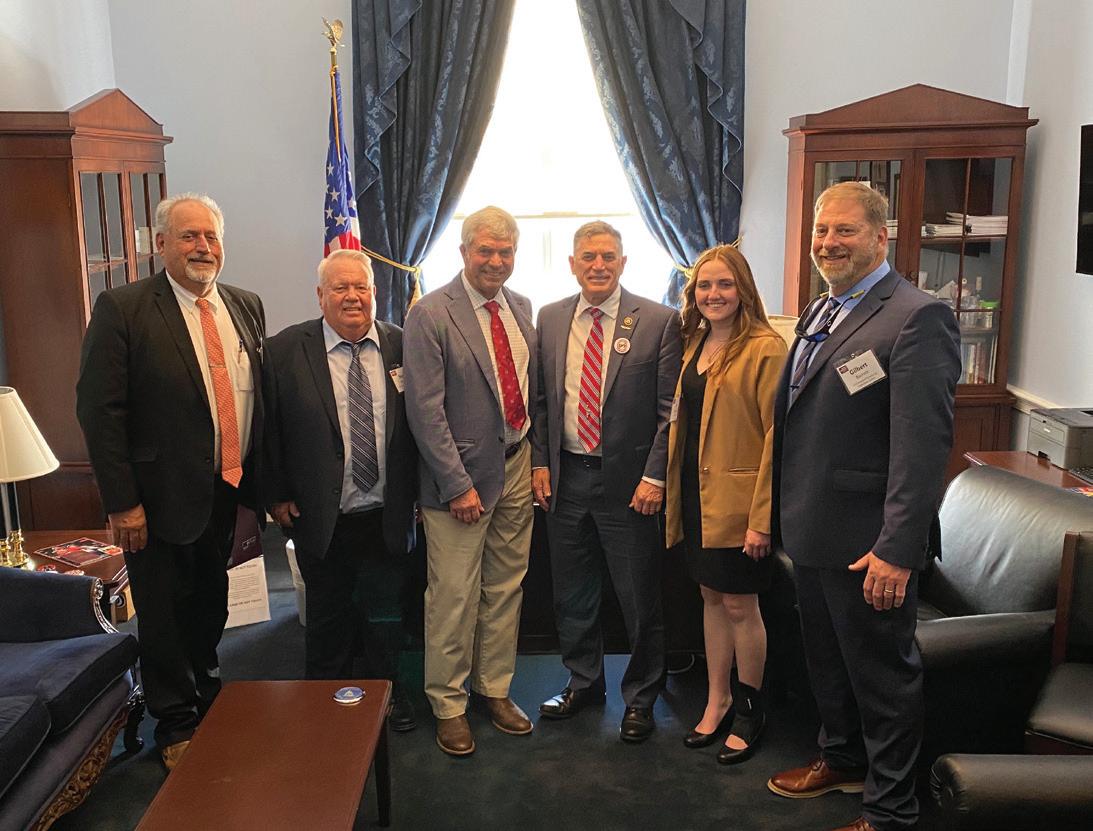
LABOR
The GFB group also heard from AFBF government affairs staff John Walt Boatright, Courtney Briggs and Economist Bernt Nelson. Boatright gave an update on labor and showed results of a Gallup poll indicating 71% of Republicans, 36% of Independents and 19% of Democrats say they want decreased immigration to the U.S.
“When members of Congress go home, no matter if they're talking to an independent, Republican or a Democrat, they're hearing that we need decreased immigration in the United States. That doesn't help our cause when we start talking about the reforms we need to see in the H-2A program,” Boatright said.
Boatright noted inaction by Congress gives federal agencies an opportunity for rulemaking.
“In the past 18 months, we've had eight different rulemakings that have occurred that affect agricultural employers, and in some cases specifically H-2A employers,” he said.
NASS TO DISCONTINUE CATTLE REPORT AND COTTON SURVEY
Nelson reviewed factors affecting the U.S. cattle inventory after the National Agricultural Statistics Service (NASS) January report showed the national cattle herd at its smallest number since 1951.
While the GFB group was in Washington, NASS announced it is discontinuing the July Cattle Inventory Report due to budget constraints. NASS is also halting the Cotton Objective Yield Survey and all county estimates for crops and livestock beginning with the 2024 production year.
“When you're looking at our Price Loss Coverage or some of the insurance and county level data, that type of data is available through RMA (Risk Management Agency) rather than NASS,”
Nelson said. “So that one has a bit of a replacement and that may be one of the reasons that cutting that July inventory report is a big deal. This includes county level estimates for both crops and livestock sector. Cotton can get it from RMA, but there’s other crops and cattle that we can't get that county level data anywhere else. We're going to be down to just one report on January first that reduces our ability to manage risk. This is a gargantuan blow to transparency and undoes so much of what the AMS did with the cattle contract library.”
UPDATE ON FEDERAL WATER ISSUES
Briggs reviewed the ongoing legal challenges surrounding water. While farmers were encouraged by the Supreme Court’s decision in Sackett v. EPA, which struck down the significant nexus test as a means for defining what constitutes a water of the United States, the EPA and U.S. Army Corps of Engineers’ updated rule to comply with the court’s order fell short of providing much-needed clarity.
“What the conforming rule didn't do was, it didn't give more clarification to what ‘relatively permanent’ means,” Briggs said. “That was a perfect opportunity for the agencies to do that. But they don't want to do that because when they leave these terms very ambiguously defined, again, it gives them more authority and ability to push to the outer bounds of what is legal. When you don't give a clear definition of what relatively permanent means in the linchpin of how to regulate and establish jurisdiction, of course even the regulators are confused about how to implement this moving forward.”
Briggs noted that some states are starting to reassess what waters of the state are being protected and encouraged GFB members to keep an awareness of state actions pertaining to jurisdictional control over bodies of water.

Summer 2024 13 Georgia Farm Bureau News
GFB members visit Ga. 9th Congressional Dist. Rep. Andrew Clyde, third from right. / Photo by Alex Bradford
Ga. 8th Congressional Dist. Rep. Austin Scott, far right, discussed the pending farm bill when he met with GFB members' in his office. /Photo by Jay Stone
ntil this spring, U.S. farmers had only experienced Highly Pathogenic Avian Influenza (HPAI), commonly called avian flu, infecting poultry flocks.
Then, on March 20, the H5N1 strain of avian flu was found in goat kids in Minnesota on a small farm where they shared a water source with backyard poultry that tested H5N1 positive in February. From March 25 to May 16, cattle at 51 dairy farms in nine states tested positive for H5N1. As of May 16, the virus had not been found in a Georgia dairy herd.
The USDA issued a federal order effective April 29 requiring all lactating dairy cattle test negative for H5N1 avian influenza before being moved across state lines.
At press time, one person had tested positive for H5N1 related to cases of the virus in dairy cattle. In April, the CDC reported a person in Texas exposed to infected cattle reported eye redness (consistent with pink eye), as their only symptom. The patient was treated with an antiviral drug for flu.
BACKGROUND OF H5N1 IN DAIRY CATTLE ••••••••••
From March 25-May 16, USDA confirmed H5N1 in dairy herds in Texas, Kansas, Michigan, Idaho, New Mexico, Ohio, North Carolina, South Dakota and Colorado. Texas, Kansas, Michigan, New Mexico, Idaho and Colorado had multiple dairy herds test H5N1 positive.
According to the American Veterinary Medical Association, this is the first time avian flu has been found in dairy cattle.
Wild migratory birds are believed to be the source of avian flu infections in the herds in Texas, Kansas and New Mexico. USDA and/ or state officials in at least four states - North Carolina, Michigan, Idaho and Ohio – reported dairy herds infected with H5N1 in these states acquired cows from infected Texas dairy herds before the Texas herds tested positive.
USDA estimates about 10% of the cattle in infected herds are symptomatic. Most have recovered within two weeks with little to no deaths, the USDA says. Due to this low percentage and because the cows recover, dairy herds are not being depopulated. Unlike dairy cows, poultry flocks have a high mortality rate when infected with avian flu.
Since the start of the 2022 H5N1 outbreak, the USDA has confirmed HPAI in more than 200 wild mammals nationwide https://gfb.ag/usdahpaimammals

As of May 16, avian flu had not been found in a Georgia dairy herd. /Photo
USDA believes there is cow-tocow transmission. One possible way the virus may be spreading between lactating cows is via milking equipment. A cow’s udder is cleaned and disinfected before the milking machine is attached, but milk droplets from an infected cow remaining in the suction cups could be passed to the next cow.
Cows infected with HPAI are exhibiting symptoms including decrease in milk production (10-30 lbs./cow), low appetite and fever, the USDA reports.
By Jennifer Whittaker
DAIRY CATTLE MUST BE TESTED TO MOVE INTERSTATE
Georgia producers needing to move lactating dairy cattle out of state should contact the Georgia Department of Agriculture (GDA) at 404-656-3667. Samples of milk must be collected, and negative tests results obtained at least seven days before moving
14 Summer 2024 Georgia Farm Bureau News
•••••••••••••••••
by Logan Thomas
cattle. A cow testing positive for HPAI must wait 30 days to be retested.
USDA requires all samples to be collected by a licensed veterinarian or someone the GDA approves. Dairy producers may contact Georgia Milk Producers Executive Director Bryce Trotter at 229-221-3906 or GDA if they don’t have a vet to pull samples
Owners of cattle cleared for interstate movement must provide epidemiological information, including animal movement tracing.
Lactating dairy cows may be moved from a farm to a sale barn
For complete information on the testing order visit www.gfb. ag/usdah5n1dairytestinfo and www.gfb.ag/usdaclarifiestestingorder. USDA is providing financial assistance to dairy producers to cover the cost of testing cattle, implementing biosecurity measures for workers/encourage them to be tested, and other costs associated with an infected herd. For details visit https://gfb.ag/usdahpaifarmercompensation.

in the same state without being tested.
Subsequent interstate movement of a lactating dairy cow from a sale barn directly to a slaughter facility requires only a Certificate of Veterinary Inspection (CVI) stating the animal is clinically healthy. Lactating dairy cows showing no signs of H5N1 may move across state lines directly to slaughter if they have a CVI or other document the state veterinarians in both the sending and receiving state approve.
USDA recommends all animals moved on/off a premise be isolated for 30 days to prevent the spread of disease.
PASTEURIZED DAIRY PRODUCTS SAFE TO EAT
On April 26, the U.S. Food & Drug Administration (FDA) said tests it did on pasteurized milk taken from store shelves in 38 states show pasteurization is effective in killing the strain of H5N1 found in dairy cows and that pasteurized U.S. milk and dairy products are safe for human consumption.
FDA also tested samples of retail powdered infant formula and toddler formula. The FDA reports all results of formula testing were H5N1 negative. FDA, Centers for Disease Control (CDC) and the USDA maintain that consuming pasteurized dairy products is the safest way to assure dairy products are safe to consume.
H5N1 HAS NOT BEEN FOUND IN GROUND BEEF
On May 1, USDA announced that H5N1 has not been found in any of the samples of ground beef from across the U.S. that it tested. USDA collected samples of ground beef from retail stores in each state with dairy herds that tested positive for H5N1 at the time the samples were collected.
To verify the safety of the U.S. meat supply from H5N1, USDA is working on two separate beef safety studies related to avian flu in meat from dairy cattle.
Meat and eggs from poultry farms with avian flu are destroyed before entering the food supply.
Visit www.gfb.ag/usdaavianfluinfo for USDA updates & biosecurity resources.
Summer 2024 15 Georgia Farm Bureau News
•••••••••••
••••••••••
Yellow-Legged Hornet
A New Season of Tracking & Eradication
By Jennifer Whittaker
It’s time to resume watching for the invasive yellowlegged hornet (YLH) first spotted in the Savannah area last August. By the end of 2023, the Georgia Department of Agriculture (GDA) identified and arranged for exterminators to destroy five mature YLH nests in Chatham County.
The YLH destroys honey bees that pollinate many Georgia crops. It’s native to tropical and subtropical areas of Southeast Asia but is established in Europe, parts of the Middle East and parts of Asia where it isn’t native.
In its Dec. 15, 2023 YLH Ledger, the GDA reported, “As temperatures drop, hornet activity naturally decreases. Through research, we know all hive members die off over winter except for future queens. We expect this will be the same in Georgia.”
On April 8 and 13, two Savannah area residents observed and reported YLH queens with embryo nests. Both were destroyed.
GDA says mated YLH queens emerge in the spring to find a food source, build a small nest and begin producing workers. Embryo nests can range in size from a ping pong to a tennis ball and are usually found under sheltered areas like building eaves.
As a YLH colony grows, it forms a much larger secondary nest in summer. These tend to be built 80-100 feet up in trees.
Beekeepers across Georgia can make simple traps to watch for the YLH using plastic juice containers and other common items.
The GDA has an instructional video on making a trap at agr.georgia.gov/Yellow-Legged-hornet, along with the latest updates and information.
Residents who see a suspected YLH, YLH embryo or mature nest are encouraged to take a photo and report it using an online form at a link located at the bottom of the aforementioned YLH webpage or email yellow.legged.hornet@ agr.georgia.gov.
If you remove a YLH nest, it's crucial to ensure the queen has been eliminated to prevent her from establishing another nest. If unsure about removing a nest, contact GDA.
GDA has established a Facebook group: Georgia Hornet Watch to help educate Georgians.
GDA had 170 YLH traps in place by Dec. 15 that staff monitored over the winter. GDA has hired additional staff to help identify, track and monitor the 1,000 traps it plans to put out this year.
GDA is now attaching lighter RFID trackers to captured YLHs that improve the chances of tracking a hornet back to its nest. GDA staff are using wing frequency sensors calibrated to recognize the YLH’s unique wingbeat speed to help detect YLH activity from the ground.
GDA is working with UGA Extension, USDA, Clemson University and the University of Florida to track and eradicate the YLH.

16 Summer 2024 Georgia Farm Bureau News
YLH
Bald-Faced Hornet Nest
Embryo Nest *Courtesy of GDA
Identifying Characteristics
1. Size
Adults are about 2cm long. Comparison of common look-alikes found in Georgia are shown.
2. Narrow Waist
Look for a narrow waist, more cinched than the sawfly look-alike shown.
3. Yellow Legs (bottom half)
The namesake characteristic of YLH is the yellow color found on the bottom half of the insect's legs.
4. Yellow 4th Abdominal Segment
Look for a strong yellow stripe on the fourth abdonimal segment shown here with arrow.
*Information courtesy of University of Georiga Extension




Summer 2024 17 Georgia Farm Bureau News Serving you from 10 locationS | tidewaterequip.com Special Financing on All Used Magnum Tractors 3.9 % for 36 months GA Farm Bureau - Edition 1 - 2024 page A.indd 1 1/22/2024 8:18:44 PM
Yellow-legged Hornet (Vespa velutina)
Pigeon Horntail Sawfly (Tremex columba)
4cm 2.5cm 2cm
Eastern CicadaKiller Wasp (Sphecius speciosus)
Narrow Waist
Scan
Yellow Leg (bottom half of leg)
to Report
Yellow 4th abdominal segment
Georgia Department of Ag Celebrates 150 YEARS
By Jay Stone
In 1874, whether to establish the Georgia Department of Agriculture was controversial. So much so that, on Feb. 28 that year, the Georgia House of Representatives produced a tie vote on the bill to establish the department.
It was up to then-House Speaker Augustus Bacon to cast the deciding vote. Bacon, for whom Bacon County is named, voted to establish the department, and Georgia became the first state with a department of agriculture.
Today, the GDA serves many roles. It is a regulatory, marketing and a consumer protection agency that impacts all Georgians every day. GDA’s regulatory oversight spans from the gas pump to the grocery store and almost everywhere in between. The department has more than 550 employees who work to ensure the safety of our food supply, help Georgia farmers and promote Georgia agriculture. GDA’s Farmers & Consumers Market Bulletin is known throughout the state for its classified ads for farm equipment, livestock, seeds & plants, dogs and more.

In 1974, Gov. Jimmy Carter & other state officials marked the Department of Agriculture's centennial with Agriculture Commissioner Tommy Irvin, center, at the Georgia capitol. Irvin served as ag commissioner from 1969 to 2011.
Photo courtesy of GDA archives
On Feb. 28, 2024, many of the department’s employees gathered in the state capitol rotunda with members of the Georgia House and Senate Agriculture Committees and agricultural stakeholders from across the state to mark GDA’s 150 years.


Brian Kemp presents Agriculture Commissioner Tyler Harper with a proclamation recognizing the important work the Georgia Department of Agriculture does.
18 Summer 2024 Georgia Farm Bureau News
Next page, a bound copy of the 1874 law was displayed. The official anniversary cake was a seven-tiered creation emblazoned with key documents noting GDA’s history. /Photo by Jay Stone
Agriculture Commissioner Tyler Harper emphasized the crucial place agriculture holds in determining Georgia’s success. /Photo by Nick Vassy, GDA
Gov.
Photo courtesy of Gov. Kemp’s office

“We’re not only here to celebrate the department’s 150 years of service to the people of this state, but we’re here to celebrate the vital role that agriculture has played and continues to play in the success of our state,” Agriculture Commissioner Tyler Harper said. “The story of agriculture in our state is rich with tradition and history, and it’s a story that’s worth telling.”
Current House Speaker Jon Burns assured the crowd the department is here to stay.
“If that vote were to come around again now, the result would be the same,” Burns said.
Gov. Brian Kemp, a staunch supporter of Georgia’s largest economic sector, said the department continues as a vital component of state government.
“Our department of agriculture has been an institution Georgians have depended on for generations,” Kemp said. “Obviously its functions have changed with the times, but it's my belief that the institution's importance in our state has never been higher. No matter how many industries grow across our state, we will always need agriculture as our foundation on which our economy is built.”

Welcome Georgia Farm Bureau Members

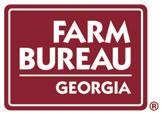



Summer 2024 19 Georgia Farm Bureau News Schedule Your Appointment Today (877) 684-3329 REFERRAL CODE : GAFBGNWI24 greathearingbenefits.com/farm-bureau/georgia THE BEST DEAL ON HEARING AIDS AND CARE
As a member of the Georgia Farm Bureau you have access to the Great Hearing Benefits (GHB) program. GHB provides family members access to hearing care and hearing aids at discounted rates. © 2023 GN Hearing A/S. Great Hearing Benefits is a registered company owned by GN Hearing A/S. All rights reserved. 1 Deductible required. 2 Immediate family members include father, mother, husband, wife, son, daughter, brother, sister, grandfather, grandmother, father-in-law, mother-in-law, sister-in-law, brother-in-law, and domestic partner and civil unions recognized under State law. 40% OFFonJab dioProducts Member SavingsUpTo Get up to 50% Off Prescriptive Hearing Aids Free 60-Day Hearing Aid Trial Share Your Benefits2 with up to 3 family members 3-Year Warranty and Service1 5,000+ Locations Nationwide
FARM INJURY ACCIDENT?
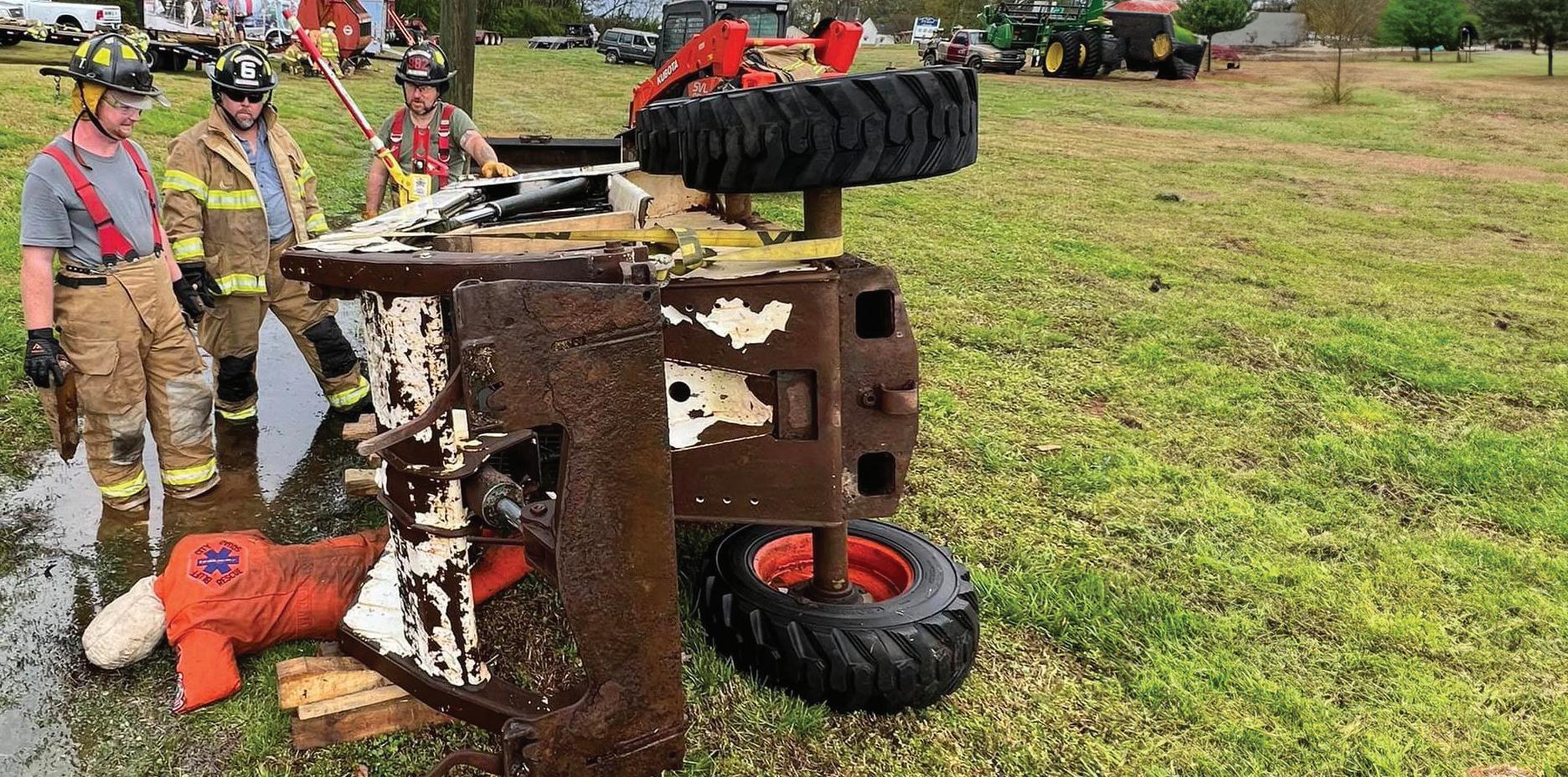
Statesboro trauma surgeon Dr. John Martin says preventing a farm injury can be as simple as exercising common sense.
“If it looks like it might be dangerous, don't do it,” Dr. Martin says. When prevention fails, there are things that can be done to prevent an injury from becoming fatal after you call 911 and wait for medics to arrive.
Martin’s top advice is: Do no additional harm. If possible, leave the person where they are and stabilize them. Martin’s advice for common farm injury scenarios are:
Amputation
In some cases, a limb or a digit can be reattached surgically. To make this possible, the severed body part must be retrieved, cleaned and kept cool.
“If you've got a source of clean water, rinse the part off, put it in a plastic bag and then wrap that in a towel and knot it.”
Martin warned against freezing the amputated portion, which kills tissue.
“Don't put the body part in direct contact with ice,” he said.
Crushed by equipment
“Let's say a piece of equipment just rolled over [someone] and they're lying in the field,” Martin said. “You don't want to move that person unless you absolutely must. Call for rescue and try to keep them warm. Even if it doesn't seem cold, the body responds to traumatic situations by losing temperature. Cover them up. Keep them shaded if it's hot. Warm them if it's cool.”
Impalement
If an object has pierced through a person, Martin says leave the object in place. The object might be preventing bleeding. Removing it could make the injury worse. If the ends of the object
Tips to Help
By Jay Stone
must be cut down to transport them, let a medic or someone with first responder training do that.
“Leave it in there. It needs to come out carefully,” Martin said.
Broken limb
Stabilize a fractured arm or leg by securing it to something rigid like sticks, a piece of lumber, PVC pipe or steel rod.
“All bones are associated with nerves, arteries and veins,” Martin said. “If you have a fracture that has not yet lacerated a vascular or a neurological element, and you try to reduce it yourself, you very likely will make the injury worse. Leave setting the limb to the professional.”
The same advice, he said, goes for dislocations.
“If it's dislocated, pointing in any direction, immobilize it like it is. Don't try to fix it.”
Unconscious but breathing
“You must be careful with moving injured victims without knowing how to do it. When the EMTs roll in, they'll put a collar on them, use a spine board and maintain traction on the neck and the neurological elements to prevent that injury from precipitating a more traumatic event.”
Poisoning
Most farm chemicals can be lethal if they contact facial features, large areas of skin or are ingested. Call 911 and then the Georgia Poison Control Center at 1-800-222-1222.
Martin advises wearing gloves and face shields when treating a poisoning victim.
“The first thing is, don’t get it on yourself,” Martin said. “If the person's clothes are covered [with the chemical], strip those off. Irrigate them with water to wash the chemical off the skin. Then,
20 Summer 2024 Georgia Farm Bureau News
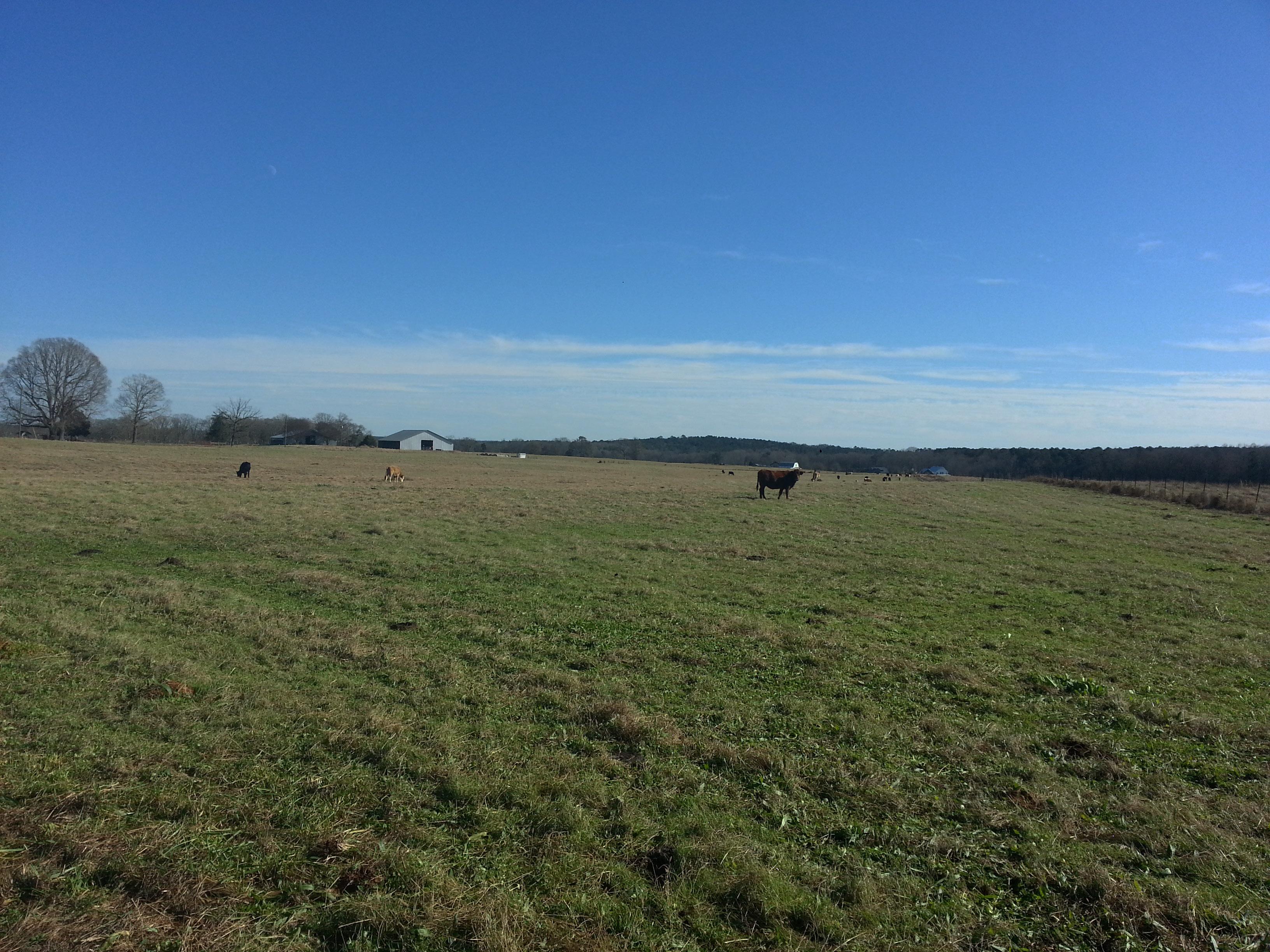
be concerned about hypothermia and cooling the person down too much.” Wrap them in an uncontaminated blanket or clothing to fight hypothermia.
Heat stroke
Drink lots of water and take breaks when working outside on hot, humid days. Take precautions even on cloudy or cool days.
For someone with a heat-related injury, take steps to cool them: move them to a shaded area, get them to drink water, loosen or remove clothing and ice areas of the body where blood vessels are most exposed, like the armpits and the groin.
Gunshot wounds
Martin emphasized that stopping blood loss is job one.
If the wound is where a tourniquet can help, use or make one. A blood pressure cuff can work as a tourniquet. If one isn’t available or the wound is in a place that can’t be treated with a tourniquet, put a bandage or cloth over it and apply pressure.
Tourniquets should be placed between the wound and the heart.
“If you're shot below the knee, put one above the knee. If you put one on and that doesn't stop it, you put another one on,” Martin said.
The smaller the diameter of the extremity – think lower shin as opposed to thigh –the greater the likelihood you’ll be able to compress the artery.
“If you're shot above your ankle, put the tourniquet below the knee, right above the wound entry,” he said.
Mauling
If you encounter a person mauled by an animal, first ensure the animal can do no further danger. Then, stop the bleeding using a tourniquet or bandages and pressure.
“You have a potential for significant blood loss,” Martin said.
“The number one thing you can do to save people's lives is have a tourniquet. If you have lots of lacerations, you want to try to control the bleeding.”
Snake bite
When possible, keep the body part where the bite occurred lower than the heart. Forget how snake bites are treated in movies.
“Do not cross hatch the bite wound and suck on it [to remove venom]. You want to reduce the flow of venom towards the heart. Don't put a tourniquet on it. Don't elevate it. If possible, head immediately toward the hospital for treatment,” Martin said.
If you’re bitten, get somebody to drive you.
Frostbite
We may not associate cold-related injuries like frostbite with Georgia’s warm climate, but they do happen. Martin recommends protecting the body part by covering it, then seek medical attention.
“The skin that’s dead will peel off, he said. “Often, you'll have healing underneath over time. Sometimes we must amputate, but not very often.”
This article is for educational purposes only. Follow recommendations of trained medical professionals offered via phone or once they arrive on scene.

Dr. John Martin, standing, gives a group of Georgia Farm Bureau 7th District Young Farmers & Ranchers first aid tips to respond to various injuries they may encounter on the farm.
by Jay Stone


Summer 2024 21 Georgia Farm Bureau News Help the next generation of Georgia farmers Do you have land to lease, sell, rent or share? GA FarmLink can match your land with hundreds of potential farmers & growers. Scan to visit gafarmlink.org
Photo

Georgia Farm Bureau President Tom McCall congratulates the 20232024 Georgia Junior National Grand Champions, from left, Jaleigh Hurst, Ava Lynn Cravey, Ava Smith, Laurel Christopher, Levi Roberts, Aubrey Welch, Katherine Colletti and Emily Strickland.
Photo by Jay Stone
GA Jr. Livestock Champions
By Jennifer Whittaker
WIN CASH & BUCKLES
Georgia Farm Bureau (GFB) celebrated the newest group of Georgia Junior National Livestock Show grand champion exhibitors during its Evening of Champions dinner, May 3. GFB welcomed the students, their families, FFA advisors and 4-H agents to its state office in Macon.
“Your accomplishments are a testament to the values of hard work, perseverance and determination, and serve as a reminder that with dedication and passion, anything is possible,” said GFB President Tom McCall. “Georgia FFA and 4-H play a vital role in fostering the next generation of agricultural leaders and providing opportunities for young people to learn, grow and excel.”
This is the 13th year GFB has sponsored the cash prizes and belt buckles awarded to the Ga. Jr. National Livestock grand champion species exhibitors.
The Ga. Jr. National is open to Georgia 4-H and FFA members from across the state. The show is the culmination of the two youth programs’ livestock projects, which give students a chance to learn how to care for beef cattle, dairy heifers, hogs, goats and lambs for months, train them to be shown, and then compete for state honors as having the best animal in the various species categories.
At the 2024 Ga. Jr. National Livestock Show, held Feb. 21-24 at the Georgia National Fairgrounds & Agricenter in Perry, 406 students showed 759 beef heifers; 183 students showed 258 market heifers or steers; 200 students showed 258 dairy heifers; 1,086 students showed 2,081 hogs (barrows & gilts); 153 students exhibited 289 ewes; 226 students showed 426 does.
About 355 4-H and FFA members showed 701 goats in the 2023 Georgia Jr. Market Goat Shows held at the Agricenter last October while the 2023 Georgia Jr. Market Lamb show drew 222 exhibitors who showed 480 lambs.
GFB awarded a total of $18,000 in prize money to the grand champion exhibitors who are: Beef Heifer - Emily Strickland, Madison Co.; Breeding Doe - Katherine Colletti, Oconee Co.; Commercial Dairy Heifer -Ava Smith, Gilmer Co.; Market Barrow & Market Gilt - Ava Lynn Cravey, Dodge Co.; Market Beef Cattle (steer) - Jaleigh Hurst, Thomas Co.; Breeding Ewe & Market Lamb - Laurel Christopher, White Co.; Market Doe - Aubrey Welch, Lincoln Co.; and Market Wether - Levi Roberts, Worth Co.
Visit www.gfb.ag/24gajrchampions to read more about each exhibitor.
22 Summer 2024 Georgia Farm Bureau News
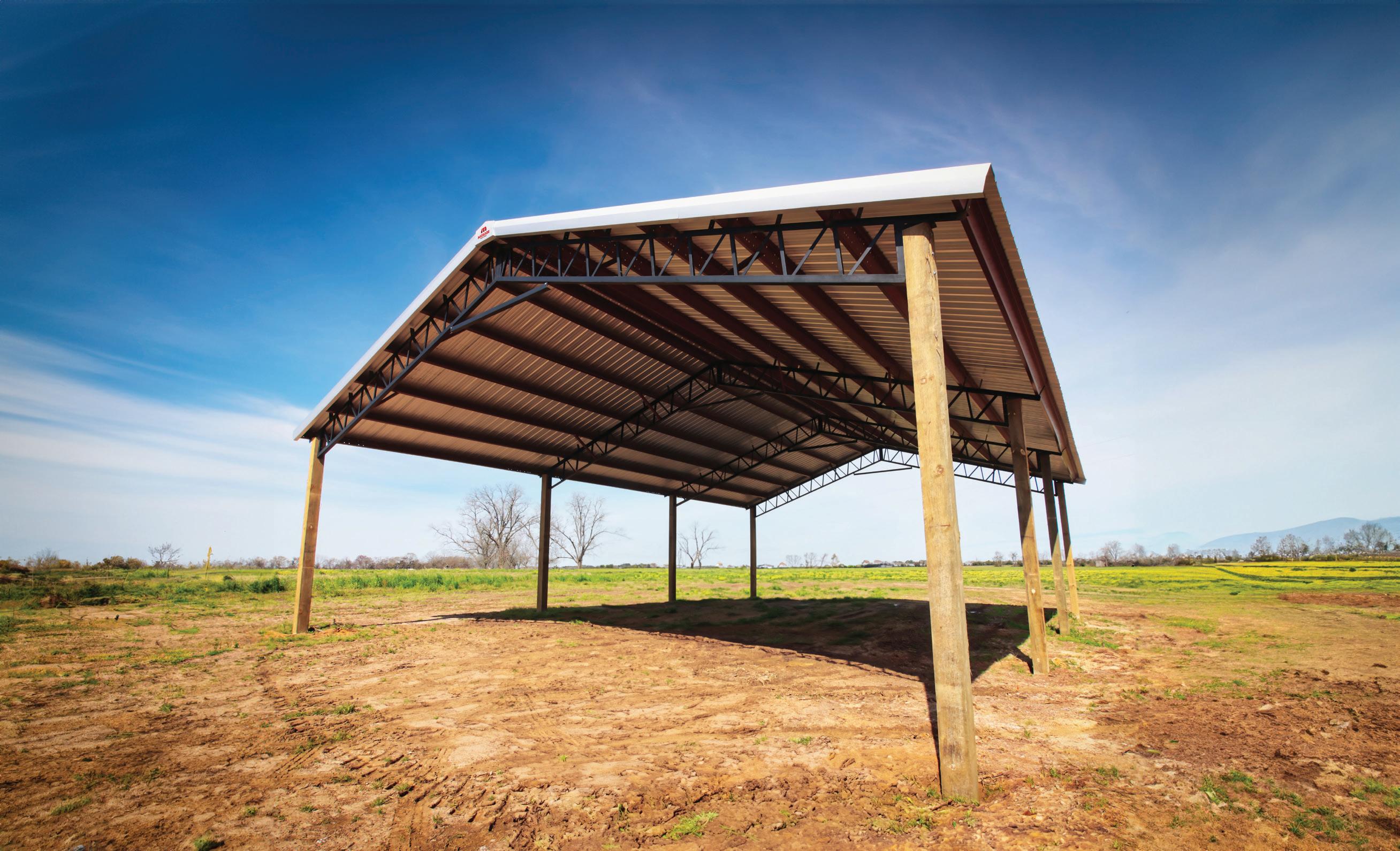




Summer 2024 23 Georgia Farm Bureau News $82,000 Serving you from 10 locationS | tidewaterequip.com 121f compact c wheel loader w tv450B tv450B compact loader c $49,500 GA Farm Bureau - Edition 1 - 2024 page B.indd 1 1/22/2024 8:29:44 PM PROTECTIVE STEEL ROOF RIDGE AND RAKE TRIM RED IRON PURLINS 105-145 MPH WIND RATED OPTIONS 20 ROOFING COLOR OPTIONS BLACK ANGLE IRON TRUSSES MatadorStructures.com 888.276.7976 e last pole barn you’ll ever need to buy. at is, until you buy your second one. Matador metal pole barns are engineered and made in the USA. We’re known for durability and our pole barns can last for decades. It all comes down to materials. e combination of strong metal roofing, angle iron trusses, red iron or galvanized purlins, and treated rough-cut wood posts ensures long-lasting performance. SCAN TO LEARN MORE

GFB DAY AT THE BRAVES A GRAND SLAM!
By Lily Baucom
April 7 was a beautiful day at Truist Park for the 3rd Annual Georgia Farm Bureau (GFB) Day at the Braves. The Atlanta Braves beat the Arizona Diamondbacks, 5-2, making the event extra special for GFB guests! GFB fans turned out in record numbers buying 968 game tickets, all GFB Game Day t-shirts offered and GFB foam fingers to raise $11,000 for the Georgia Foundation for Agriculture (GFA).
Before the game, GFB guests had the chance to participate in the pre-game parade and walk around the field waving to the crowd. We asked our guests to bring signs related to baseball and agriculture.
Thank you to everyone who participated! Your creativity truly made the game fun and educational. This event is a great venue to educate consumers about agriculture.
Our winners, picked from signs that were posted on Facebook with #gfbdayatthebraves, are in no particular order: Amanda

Representing Hart Co. Farm Bureau in the Braves pregame parade were Deklyn Fleming, left side of banner, HCFB Office Manager Tina Simmons (navy shirt), Raegan Link, right, and her dad, Rusty Link./Photo by Britani Link
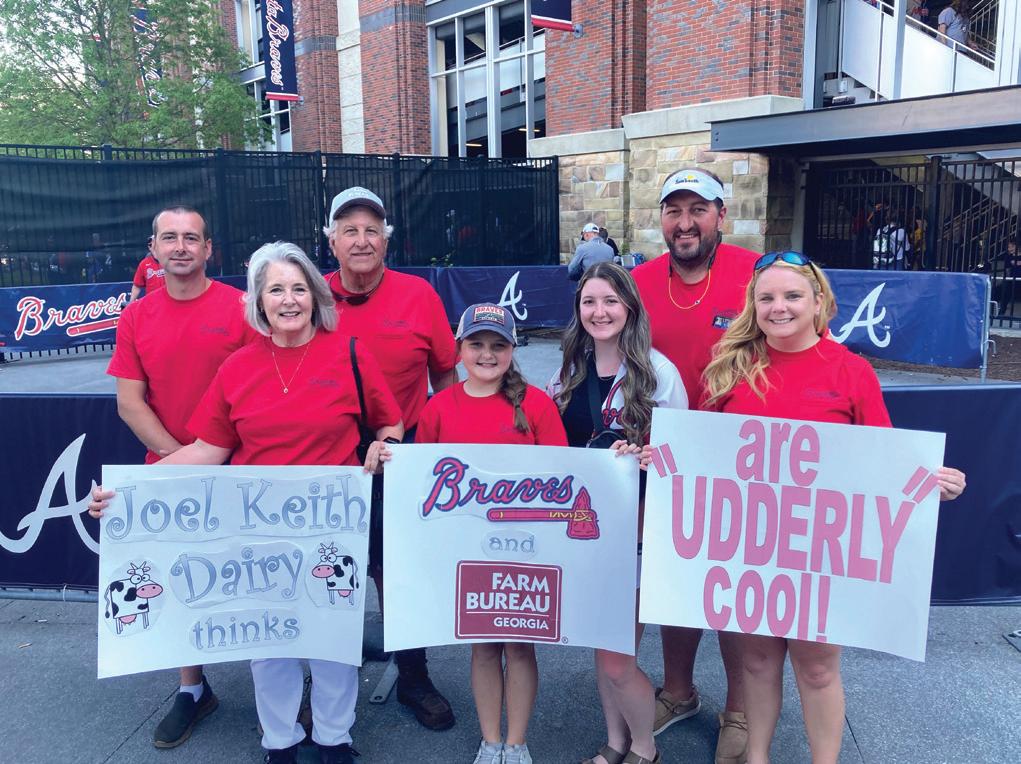
GFB Day at the Braves gave Troup County Farm Bureau members Cathy & Joel Keith, a chance to spend a memorable day at the Braves game with their sons Paul, far left, and Joseph, right, granddaughters Blakely & Baylor, and family friend Keri North. The family served as ambassadors for Georgia dairy farmers and their posters won them a Visa gift card. Photo courtesy of Cathy Keith
Miller Wooditch & Family; Bennett Jacobs & Family; Cathy Hubbard Keith & Family; Jami Williams & Family; and Rachel Martin/Blake Carter. The winners received a Visa gift card for their creativity and effort.
Visit www.gfb.ag/gfbbravesday to see more photos from the event. To learn more about the foundation’s mission or to donate to support its many programs, please visit www. gafoundationag.org/donate.
Lily Baucom is executive director of the Georgia Foundation for Agriculture. She may be reached at lrbaucom@gfb.org or 478405-3461. Visit www.gafoundationag.org to learn more about GFA programs or to make a tax-deductible donation.
24 Summer 2024 Georgia Farm Bureau News
NEW CHILDREN’S BOOK AT LIBRARIES Celebrates Georgia Pecans
For the seventh year, the Georgia Foundation for Agriculture (GFA) and Georgia EMC partnered to donate a children’s book that accurately depicts agriculture to the 394 libraries in the Georgia Public Library Service. Each county Farm Bureau received enough copies of “My Grandpa, My Tree and Me” written by Roxanne Troup to give one to all public libraries in its county on behalf of the GFA and Georgia EMC. This book tells the story of a grandfather planting a pecan tree for his granddaughter on the day she was born. As the tree and the little girl grow, the grandfather teaches her how to care for the tree year-round to have a bountiful harvest of nuts in the fall.
County Farm Bureau and regional EMC representatives presented the books to their local libraries in April to celebrate it being National Pecan Month.
Other ag books available at your local library, courtesy of GFA & Georgia EMC, include: “I Love Strawberries,”; “How to Grow a Monster,” about growing zucchini; “John Deere, That’s Who!”; “Right This Very Minute,” which explains how food gets from farm to table; “Full of Beans: Henry Ford Grows a Car,” which looks at products the carmaker made from soybeans; & “Tales of the Dairy Godmother, Chuck’s Ice Cream Wish,” that takes readers to a dairy
farm. “Sleep Tight Farm” and “Hi, I’m Billy Blueberry This is My Story,” are available courtesy of GFA.
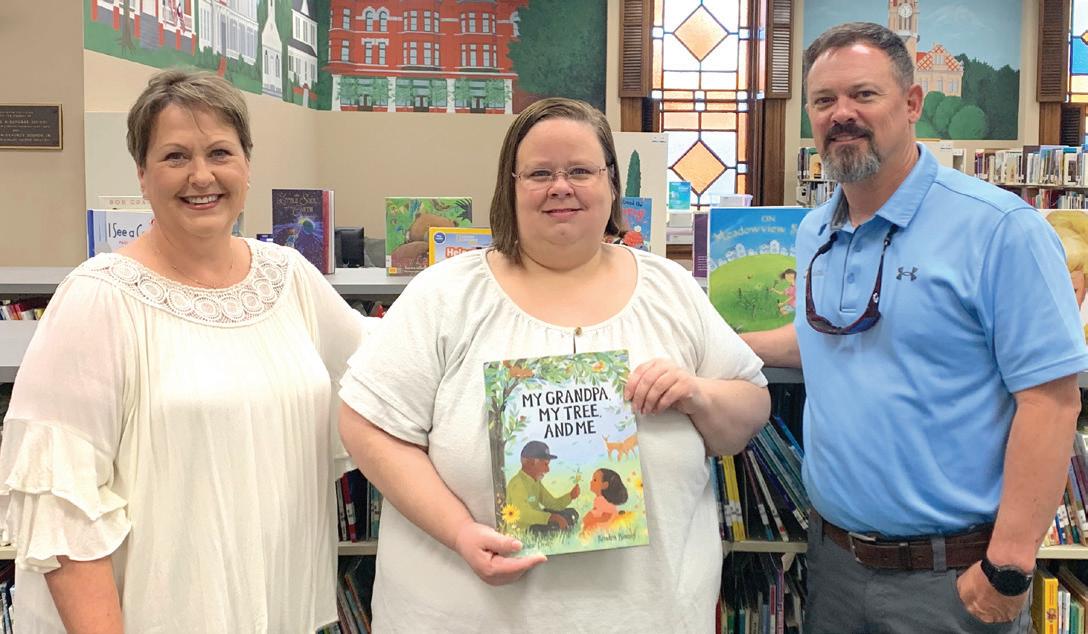
Wilkes County Farm Bureau Office Manager Rebecca Griffin, left, and Rayle EMC Director of Member Services
Richard Heard, right, present a copy of “My Grandpa, My Tree and Me” to Beth Miller, assistant director of the Mary Willis County Library, on behalf of the Georgia Foundation for Agriculture and Georgia EMC. / Photo courtesy of WCFB

We invite you to follow us on social media to stay up-to-date with all things Circle F related. We would love to see you and your family this upcoming Fall for the Circle F Farms Fall Production Sale.
Summer 2024 25 Georgia Farm Bureau News 70 PRENTISS RD. BAXLEY, GA. 31513 | WWW.CIRCLEFFARMS.COM CIRCLE F FARMS FALL SALE
OCTOBER 12, 2024
GFA AWARDS SCHOLARSHIPS TO HELP STUDENTS PURSUE AG CAREERS
By Lily Baucom
The Georgia Foundation for Agriculture (GFA) is excited to name the 24 students it has selected to receive a total of $65,000 in scholarships for the 2024-2025 academic year. GFA scholarships are awarded to students who intend to pursue or are pursuing degrees in agriculture, forestry or family and consumer sciences at a school that is part of The University System of Georgia, Berry College, Emmanuel University or any accredited college/ university in Georgia with an ag program or a Georgia accredited technical college.
“The Georgia Foundation for Agriculture is proud to recognize another crop of students who have shown they are passionate about agriculture through their extracurricular activities and chosen majors,” said GFA Board Chairman and GFB President Tom McCall. “Georgia Farm Bureau is pleased to support the foundation’s efforts. We look forward to seeing what these students will accomplish as future leaders in Georgia agriculture.”
The scholarships are for graduating high school seniors headed to college or a technical college next fall, rising college juniors and seniors, and students enrolled in the University of Georgia College of Veterinary Medicine who plan to care for farm animals. Recipients are listed below.
College Freshman Scholarship for Agriculture
Ten students planning to enter college this fall at Fort Valley State University (FVSU), Abraham Baldwin Agricultural College (ABAC), Berry College, and the UGA College of Agricultural & Environmental Sciences (CAES) were awarded scholarships of $3,000 each: Andrew Carnley, Houston County; Amelia Housley, Franklin County; Eva Wessels, Lee County; Carson Lynn, Decatur County; Holt Sapp, Burke County; Katie Moncrief, Crawford County; London Osteen, Coffee County; Macey South, Upson County; Kyle Kitchens-Hayes, Bryan County; and Stephen Peterson, Lowndes County. The top two candidates – Carnley and Osteen – each received an additional $1,500. These 10 students plan to pursue degrees in animal science, agribusiness, regenerative bioscience, environmental resources science, veterinary technology and applied biotechnology.
Technical College Scholarship for Ag
Addie Pierce, Barrow County; Colton Bartmas, Stephens County; Eben Banks, Tattnall County; and Jessi Humphries, Franklin County were each selected to receive a $1,500 scholarship to attend North
Georgia Technical College, Athens Technical College, Ogeechee Technical College and Gwinnett Technical College. These students plan to pursue agribusiness, environmental technology, and veterinary technology degrees.
Rising College JR/SR Scholarships for Ag
The foundation awarded eight $2,000 scholarships to these rising college juniors and seniors: Anna Clifton, Bulloch County; Bethany Champion, Gordon County; Carrie Keown, Miller County; Daniel Peterson, Lowndes County; Hannah Williams, Telfair County; Jarrett Hancock, Irwin County; Nate McKinney, Jackson County; and Reagan Baldree, Ware County.
The students plan to attend UGA CAES and ABAC in the fall and are studying ag communication, ag education, agribusiness, agricultural economics, agriscience, environmental systems and avian biology.
UGA Veterinary Medicine Scholarship
Matt Holton, Dawson County and Logan Rutchi, Walton County will each receive scholarships of $5,000 as they study to become food animal veterinarians at the UGA College of Veterinary Medicine.
Lily Baucom is executive director of the Georgia Foundation for Agriculture. Visit www.gafoundationag.org to learn more about the foundation or to make a tax-deductible donation. Instructions for applying for the 2024-25 scholarships will be posted on the GFA website this fall.
26 Summer 2024 Georgia Farm Bureau News
Ag in the Classroom Update Farm Bureau celebrates Georgia Ag Week
By Lauren Goble
To celebrate farmers and the many contributions they make to our state, Georgia’s agriculture community celebrated March 18-23 as Georgia Ag Week. Each day had a special theme for participants to explore. This year marked the 51st anniversary of National Ag Day.
County Farm Bureaus and agricultural organizations held events in their local communities as schedules allowed throughout the month of March to raise awareness of agriculture.
Georgia Farm Bureau (GFB) provided resources and videos

Screven County teacher & Farm Bureau member Whitney Sheppard celebrated Ag Week with her students by inviting a guest to read “My Grandpa, My Tree and Me” to her class. Screven County Farm Bureau provided pecan snacks and pecan activity sheets for Sheppard’s students.
highlighting the featured commodity, pecans. Approximately 300 teachers, Farm Bureau staff and volunteers used these resources during Ag Week.
Teachers who celebrated Ag Week and posted about it to social media were entered in a drawing for a copy of the book “My Grandpa, My Tree and Me” and its accompanying educator guide, provided by GFB, and a class set of bookmarks, provided by the Georgia Department of Agriculture.
The video for March 20, “Ag Hero Day,” introduced students to Cason Anderson, a Houston County pecan farmer. To view the video visit gfb.ag/meetapecanfarmer
For “Ag Literacy Day,” March 21, GFB worked with several partners to offer videos to showcase the 2024 American Farm Bureau Foundation Book of the Year, “My Grandpa, My Tree and Me” by Roxanne Troup in multiple languages.
You can see Georgia’s Department of Agriculture Commissioner, Tyler Harper, read the book at www.gfb.ag/pecanharper . If you’d like

Echols County students had fun “shell-e-brating” Georgia Ag Week! Echols County Farm Bureau teamed up with Echols County 4-H to show students videos about pecans, read “My Grandpa, My Tree, and Me,” provide worksheets about Georgia pecans, and serve them a snack of Pecan Cream Pie Dip with vanilla wafers.
to hear Marybeth Wheeler, director of the Telamon Corporation’s center in Glennville, read the book in Spanish visit www.gfb.ag/ pecanspanish . To see Peyton Walker, a teacher at the Georgia School for the Deaf, sign the book visit www.gfb.ag/pecanbooksigning .
Georgia Farm Bureau Educational Program Coordinator Lauren Goble may be reached at ldgoble@gfb.org or 478-474-0679, ext. 5135. Visit www.gfb.ag/AITC for the latest AITC news & for resources to teach children about agriculture.

Mitchell County Farm Bureau Office Manager Wanda Faircloth, pictured, and MCFB Women's Committee Chairman Debra Cox enjoyed teaching second graders at Baconton Community Charter School about pecans during Ag Awareness Week. They shared a story, activities and Georgia pecans with the students
Summer 2024 27 Georgia Farm Bureau News
Young Farmers & Ranchers visit Omaha YF&R Update
By Breanna Berry
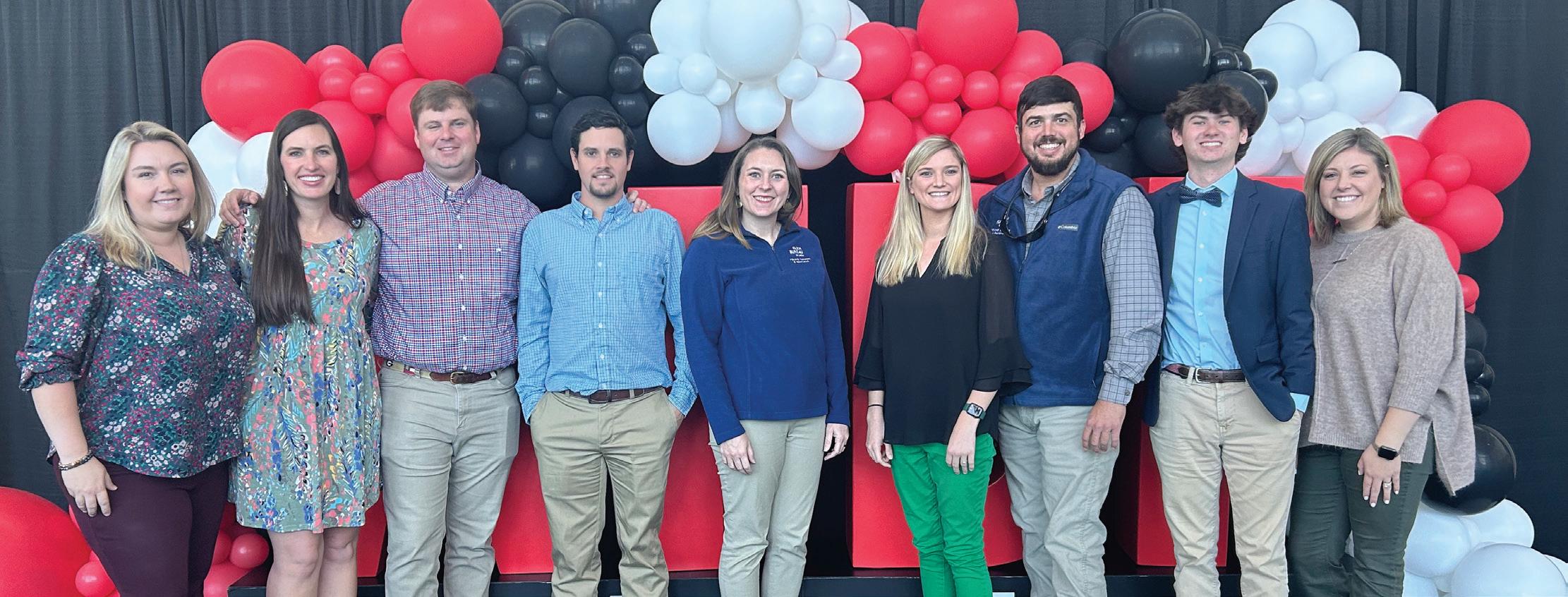
Representing Georgia at the AFBF YF&R Leadership Conference were from left: GFB 7th Dist. Field Services Manager Christie Montford, GFB YF&R Committee Chairmen Emilia & Cleve Jackson, 4th Dist. Committee Chairs Kaleb & Kaitlyn Marchant, 10th Dist. Committee Chairs Kelsie & Ryan Highsmith, YF&R member Jack Pringle and GFB Leadership Programs Coordinator Breanna Berry.
Georgia Farm Bureau Young Farmer & Ranchers (YF&R) traveled to Omaha, Nebraska, March 8-11 to attend the American Farm Bureau Federation’s (AFBF) YF&R Leadership Conference. In a Midwestern city surrounded by farm country, the conference theme was appropriately “Growing Leaders in the Heartland.”
The conference included sessions designed to sharpen the leadership and advocacy skills of the YF&R members attending from across the country. Tours of farms and ag businesses were also offered. In addition to breakout sessions, attendees got to hear from keynote speakers such as AFBF President Zippy Duvall and world-renowned motivational speaker Dr. Rick Rigsby.
During the conference, Jack Pringle of Henry County Farm Bureau competed in the AFBF Collegiate Discussion Meet. Although he did not take home the national title, Jack represented Georgia well during his time competing.
Jack was selected as GFB’s competitor by being the highest ranked collegiate contestant in the 2023 GFB Discussion Meet. He is currently attending Georgia Southern University with plans to transfer to the University of Georgia and major in agriculture education.
“Our members from Georgia loved attending the AFBF Young Farmers and Ranchers Leadership Conference. As always, one of our favorite parts was the opportunity to network and meet other YF&R members with diverse backgrounds from across the country. A bonus was the great breakout sessions and keynotes,” YF&R Chairman Cleve Jackson said. “We also always enjoy supporting our Collegiate Discussion Meet competitor and seeing the future of our organization.”
In addition to experiencing leadership development for themselves, the GFB YF&R attendees gained ideas to implement at GFB’s YF&R Conference set for July 17-20 on Jekyll Island. Registration is open until June 1 at https://gfb.ag/yfrslc. All Georgia Farm Bureau members ages 18-35 are invited to attend for a time of networking and personal growth. Contact your county Farm Bureau office for more information. Enter the GFB YFR Photo Contest at https://gfb.ag/yfrphoto by June 7.
Georgia Farm Bureau is proud to have sponsored the FFA Discussion Meet Career Development Event held at the Georgia FFA Convention on April 24. GFB congratulates the three runners-up: Sriniketh Edupuganti representing Denmark High School in Fulton County, Anna Grace Hunter from Colquitt County High School, Harrison Russ from Citizens Christian Academy in Coffee County, and the state winner John Haven Stalvey from Berrien County High School.
GFB Leadership Programs Coordinator Breanna Berry may be contacted at bcberry@gfb.org or 478-474-0679, ext. 5232. Contact your county Farm Bureau if you’d like to join your local YF&R Committee.
28 Summer 2024 Georgia Farm Bureau News
Women's Leadership Update Ladies Leading the Way
By Breanna Berry
The Georgia Farm Bureau Women’s Leadership and Young Farmers & Ranchers Committees have been busy providing programming to develop leaders and volunteers statewide. For the second year, the committees held a Legislative Drive-In the day before GFB Day at the Capitol. Thirty YF&R and WLC members from across Georgia attended the event on Feb. 12 to prepare participants to discuss ag issues with their state legislators.
American Farm Bureau Federation Senior Director of Media & Advocacy Training Johnna Miller facilitated the Legislative Drive-In workshop. Participants learned how to leverage their social media accounts to increase agricultural awareness among their friends.
GFB President Tom McCall greeted and addressed the group sharing his experience of serving as a state representative and the importance of legislators hearing directly from their constituents. GFB Governmental Affairs Specialist Adam Belflower covered topics that were priority issues for the 2024 legislative session. WLC and YF&R Drive-In attendees put the training they received into action during GFB Day at the Capitol Feb. 13.
In June, four GFB Women’s Leadership Committee members are heading to Washington, D.C., to attend the AFBF Advocate, Cultivate, Empower (ACE) Summit. This two-day event offers national learning sessions and advocacy training opportunities for
Farm Bureau women. The ACE Summit occurs every other year (in even years) to equip and prepare female leaders to engage with lawmakers and prepare them to be agricultural advocates for years to come.
The GFB WLC is hosting district meetings throughout the summer into fall. These meetings are a perfect opportunity to meet other ladies involved in Farm Bureau in your district for a time of fellowship, learning and a hands-on activity. GFB’s WLC District 6 Chairwoman Jane Wooten hosted a lunch May 9 in Montgomery County. Attendees learned to make wreaths and discussed ideas for county programming. GFB’s WLC District 7 Chairwoman Lauren Stanley hosted farm tours May 30. The group toured Vidalia Apiculture, R&K Greenhouses, Pittman Family Farms with lunch at the Hopkins Farm Pond House.
If you’re interested in attending your district Women’s meeting, reach out to your county office manager to let them know and look for announcements on the Friends of Georgia Farm Bureau Facebook group page.
Georgia Farm Bureau Leadership Programs Coordinator Breanna Berry may be reached at bcberry@gfb.org or 478-474-0679, ext. 5232. Contact your county Farm Bureau if you would like to get involved with your local Women’s Leadership Committee.
GFB's Legislative Drive-In prepared participants to advocate for agriculture with their legislators. AFBF Media & Advocacy Trainer Johnna Miller, far right, taught the workshop. GFB President Tom McCall & his wife, Jane, far left, welcomed the group along with Young Farmers & Ranchers Chairman Cleve Jackson, back row third from left, & Women’s Leadership Committee members, kneeling front row from left, Angie Roberts, Jane Wooten, Chairman Stephanie Branch, Missie Petty, Alicia Berry & Lindsey Morgan. /Photo by Breanna Berry
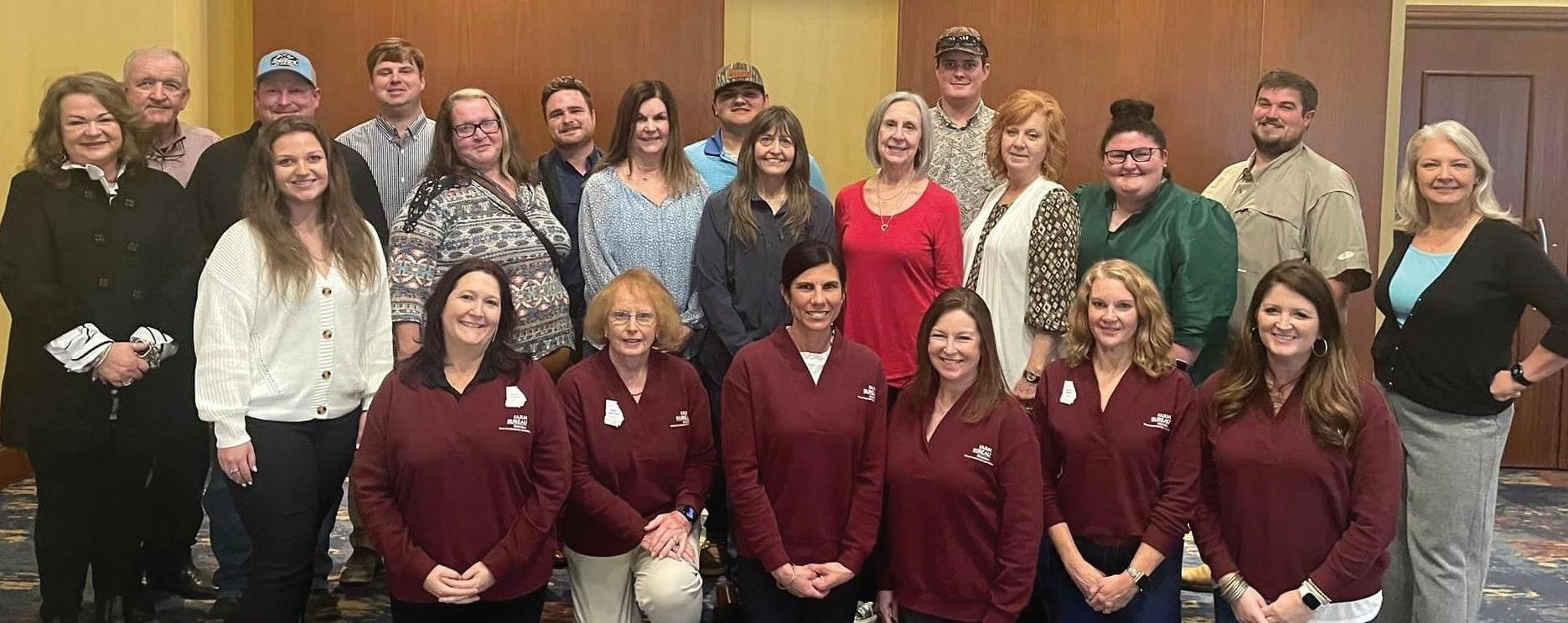
Summer 2024 29 Georgia Farm Bureau News

30 Summer 2024 Georgia Farm Bureau News
GFB & WESLEYAN COLLEGE ANNOUNCE AGREEMENT
By Jennifer Whittaker
Thanks to a memorandum of understanding Georgia Farm Bureau has signed with Wesleyan College, GFB members and employees or their family members are eligible to receive a $5,000 scholarship toward undergraduate, graduate or online tuition. This is in addition to any merit scholarship a student might receive upon entrance to Wesleyan.
“Part of Georgia Farm Bureau’s mission is to help farm families achieve an equitable standard of living and ensure agriculture remains a thriving industry. Education is key to ensuring the future success of Georgia’s rural communities and farm families,” GFB President Tom McCall said. “That’s why Farm Bureau is proud to have signed a memorandum of understanding with Wesleyan College that gives Farm Bureau members and our employees a chance to earn a degree from one of our state’s prestigious private colleges more affordably.”
Founded in 1836 in Macon, Wesleyan was the first college in the world chartered to grant degrees to women. Wesleyan offers women two undergraduate degree programs: a Bachelor of Science in nursing and a Bachelor of Arts in 24 majors.
Wesleyan also offers nontraditional students online degree programs with year-round admission for accounting, applied psychology and business administration majors.
Men and women can enroll in five graduate programs at Wesleyan. These are a Master of Business Administration, Master of Education in Elementary Education, Master of Science in Nonprofit Management, Master of Arts in Industrial-
Organizational Psychology and a Master of Music. Designed for working professionals, Wesleyan’s fast-track graduate programs are all offered online.
“Wesleyan College and Georgia Farm Bureau have a shared mission when it comes to using education as a tool for empowerment at the individual and community level,” said Wesleyan President Meaghan Blight. “Through this partnership, I know we can help Georgia Farm Bureau members of all ages access educational opportunities at the undergraduate and graduate levels to foster growth in their communities and across the agricultural sector.”
Undergraduate students enjoy living on Wesleyan’s historic 200acre campus located in north Macon. Wesleyan has basketball, cross country, soccer, softball, track, and volleyball teams that compete in the NCAA Collegiate Conference of the South. The school also has an equestrian team that competes in Intercollegiate Horse Show/Dressage Association events.
Between scholarships, grants, loans, and student employment, Wesleyan's cost of tuition can be lower than many public schools. Visit www.wesleyancollege.edu to learn about the school.
GFB employees should contact Rhea Miller at rmmiller@gfb.org or 478.474.0679, ext. 5374 for more information. GFB members interested in information about undergraduate programs should contact admissions@wesleyancollege.edu or graduate@wesleyancollege.edu for graduate programs, or call 478-757-5206. To become a GFB member, visit www.gfb.ag/join.


Summer 2024 31
Homegrown
•Designed for Small Businesses with 1-50 Employees.
•Employers Can Choose from Variety of Competitive Plans.
•Predictable, Fixed Monthly Payments.
•Broad Network of Health Care Providers. Learn more at GFBInsurance.com
Georgia Farm Bureau is excited to partner with Anthem Blue Cross and Blue Shield of Georgia to provide new health coverage options to small businesses.

Savings on Health Plans for Small Businesses.








 Tom McCall, GFB President
Tom McCall, GFB President


 By Jennifer Whittaker
By Jennifer Whittaker






 Photo by Damon Jones
Photo by Damon Jones










































